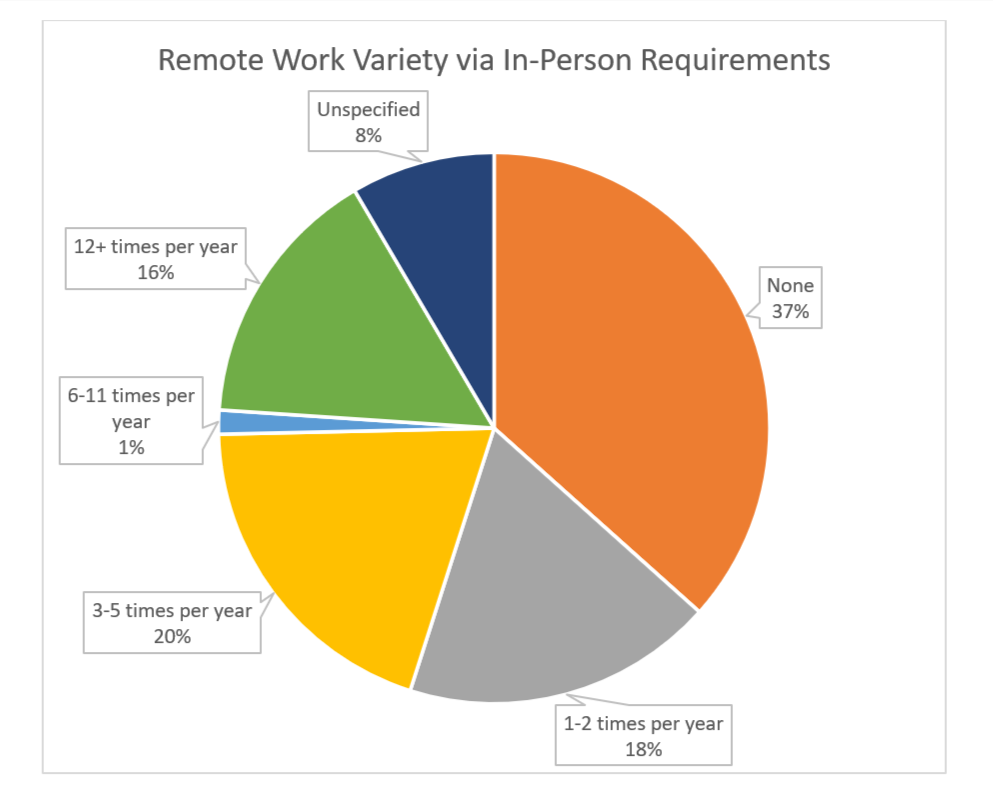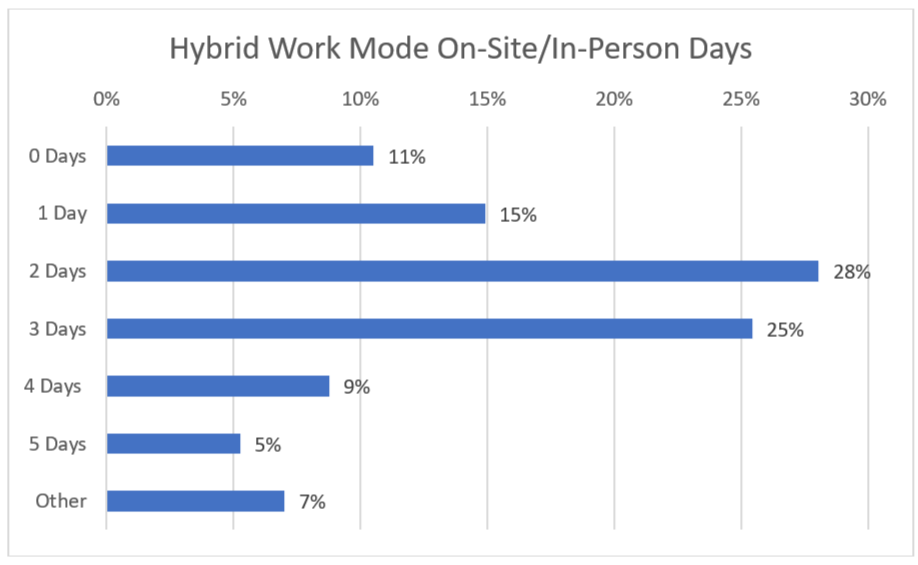Toward the end of 2021, Connections shared the results of an informal survey of 251 prospect development professionals regarding their post-pandemic workplace transitions (see “Prospect Development’s Post-Pandemic Transition”). Some major shifts in work modes — in-person, hybrid and remote — appeared in the survey responses, with the pandemic-induced boom in remote work likely being the most dramatic. With another year under our belts, it’s time to share the results of the 2022 Connections Work Mode Survey.
This survey aims to provide solid workplace and work mode data around prospect development as a profession for use in discussions with leaders, when making decisions for your time and to understand what your peers are experiencing. It’s not meant to be comprehensive, but rather a snapshot in time as the profession continues to develop following the pandemic-wrought changes of 2020.
The 2022 Connections Work Mode Survey was conducted from December 14, 2022, to February 3, 2023. One hundred seventy-six (176) prospect development professionals responded to the survey from all areas of our industry.
A few facts about the responding cohort:
- Respondents are located predominantly in the United States, with a few responses coming from Canada and Australia
- Institutional foci range from consultancies to a hands-on science museum, but higher education employees are the largest group of respondents (59%) followed by health care/medical (17%) and human/social services (6%)
- Their roles involve prospect research (88%), relationship/prospect management (72%), analytics (47%), campaigns (26%) and consulting (9%)
- 48% have three or fewer team members, 11% had teams of 16+
- 46% are managers
Shifting Work Modes, Growth and Moves
The initial survey in 2021 noted that many institutions were still shifting work modes: some transitioning back to in-person or planning to do so, while others were offering more hybrid and remote roles. The past year has certainly shown the staying power of remote and hybrid roles as central to prospect development. Perhaps more surprising is the absence of fully in-person work; hybrid work appears to have supplanted in-person work as the new normal.
Hybrid is also a way to describe how many teams are now set up. When describing their team’s work mode moving forward, 37% of respondents noted a mixed team — only 7% were all in-person, 18% were all remote, and 31% were all hybrid (7% were “unknown,” a nod to the uncertainty that still exists at some institutions). The flexibility in team setup reflects the way work modes have shifted more broadly toward hybrid/remote work and will certainly have an impact in how talent moves between institutions moving forward.
The shifting workforce is not just limited to work modes, as prospect development professionals have certainly moved around over the past few years. In fact, 24% of respondents changed jobs in 2022, and nearly double that (42%) have changed jobs since March 2020. Just over half of these changes were prompted by finding an opportunity for growth elsewhere (56% of those changing jobs) and a quarter (25%) were internal promotions; growth was a pretty big factor as respondents made decisions around changing jobs. But many institutions may still be feeling the impact of the decisions made around work modes, with 21% of those changing jobs being at least partially motivated by work mode policies at their employer.
Comparing Pre-2020 to 2022 and Beyond
With 2020 came many changes, including remote and hybrid work modes becoming routine. The 2021 survey showed the drastic shift to remote/hybrid as organizations scrambled around the impacts of the pandemic. When the 2022 survey was launched, we expected to see continued remote and hybrid work, and perhaps a bounce back of in-person work.

In 2022, and moving forward, prospect development professionals are still largely remote and hybrid, with 35% of survey respondents remote in 2022, 56% hybrid and only 9% fully in-person. The shift (visualized in the above chart) has clearly been back toward the office, as hybrid work went from 36% in 2021 to 56% in 2022, but the staying power of remote work, only dropping from 49% in 2021 to 35% in 2022 stands out.
The continued shrink of fully in-person work modes (14% down to 9%) is perhaps equally as stark, likely reflecting institutions’ willingness to maintain the new normal of hybrid/remote work. It comes down to the fact that remote work is here to stay, but so is the in-person office (albeit primarily through hybrid work).
Requirements Behind In-Person, Hybrid and Remote Work
Inside of remote work’s appearance of perpetuity, the on-site requirements for remote work can range from no explicit requirement to 12+ times a year. This certainly makes reading job posts interesting with the word “remote” having such different definitions at various employers.
While many institutions are in long-term work modes now (instead of temporary pandemic work modes) some uncertainty remains, with 8% of remote workers reporting unspecified (or inexplicit) in-person requirements. For those with more certainty, 37% retain fully remote work agreements. Those with in-person/on-site requirements seem to be split between monthly (or 12+ times per year at 16%) and those employers that require a few in-person visits (18% requiring annual or biannual visits, and 20% requiring three to five visits each year). Perhaps as remote work continues to be a part of prospect development, we’ll see these types of requirements become more standard; for now, when a job is considered “remote,” it can vary quite a bit.

Hybrid work has its own share of variety, too; creating optimal hybrid schedules for teams, departments and institutions can be challenging. To give a sense of how some prospect development teams are approaching hybrid work, the survey asked how many in-person/on-site days were required for hybrid prospect development professionals.
The large grouping of 53% with two or three days in office is probably in line with general expectations for what hybrid means. About a tenth (11%) being hybrid but working on average zero days on-site (functionally remote) might be surprising, and the same could be said for 5% of hybrid workers going into the office 5 days a week on average (functionally in-person).

Perception vs. Reality
Beyond the reality of work mode changes over the past few years is people’s reactions. Perception of hybrid, remote and in-person work has substantially shifted. So how well do employees’ ideal work mode align with the reality of their current work modes? In a word, well.
Nearly three-quarters (71%) of respondents felt their current work mode matched their ideal work mode to a certain extent, while only 12% felt there was incongruity between the two; 18% were ambivalent. This might speak to people adjusting to the new normal they first faced in 2020, or it could reflect institutions acknowledging and responding to shifts in work mode desires.
The adjustments institutions made in 2020 through 2022 will continue to ripple out over the next few years, but stability has started to creep back in — according to our respondents. When asked whether they thought their work mode would change in the next year, only 16% were on the affirmative side (and 14% unsure), while 70% of respondents believed a work mode change to be unlikely. This certainly shows a conviction amongst prospect development professionals that remote and hybrid work modes are here to stay.
Concerns Related to Work Modes
Headlines and op-eds abound when it comes to the benefits or detriments of remote, hybrid and in-person work. Whether it’s handwringing about a loss of creative spark from face-to-face interactions or praises for the broad talent pools that remote work opens, it seems like every CEO or human resources professional has strong opinions and concerns surrounding work modes. For prospect development, here are the top concerns shared by at least 20% of respondents in each category:

Broadly, all these issues bring up great topics for discussion with your organizational executives or leadership teams, or your own interactions if you’re a manager. However, one area to call out is the commonality of mental health as a concern for all survey respondents, regardless of work mode. If you’re a manager or in a position to influence your organization’s policies, making space for mental health concerns from your employees should be top of mind.
An interesting concern that only appears for in-person and hybrid professionals is productivity. This was perhaps one of the more hot-button issues early in 2020 and has remained a common theme in headlines about remote work. This isn’t to say productivity isn’t a concern of remote employees, it’s just more top of mind for those required to work in-person or on a hybrid schedule.
Finally, two related issues that pop up for hybrid and remote employees: the quality of interactions with colleagues and the quality of ideation/spontaneous conversations. Making space for quality interactions can be tricky. Add to that a mixed work mode team and it will take a flexible, agile and dedicated institution to ensure its employees have the resources necessary to facilitate spontaneous conversations, creativity and valuable connections amongst coworkers.
Hopefully digesting all these survey results, from concerns to overarching trends, provides context for your own experiences and arms you with more data points during your next discussion of work modes. Thank you to everyone that took the time to respond to this survey.
If you have any questions about the data presented here, please reach out to the Connections editors (connections@aprahome.org) or Anthony Parrish at aparrish@stanford.edu.

Anthony Parrish
Assistant Director of Development Research, Stanford University
Anthony Parrish works on the prospect development team at Stanford University as an assistant director of development research. He is a past member of the Apra Connections Editorial Advisory Committee and enjoys learning from other prospect development professionals about their best practices, research tools, et cetera. Parrish's 10+ years with nonprofits have included time in higher education, independent/secondary education, human services and community arts.